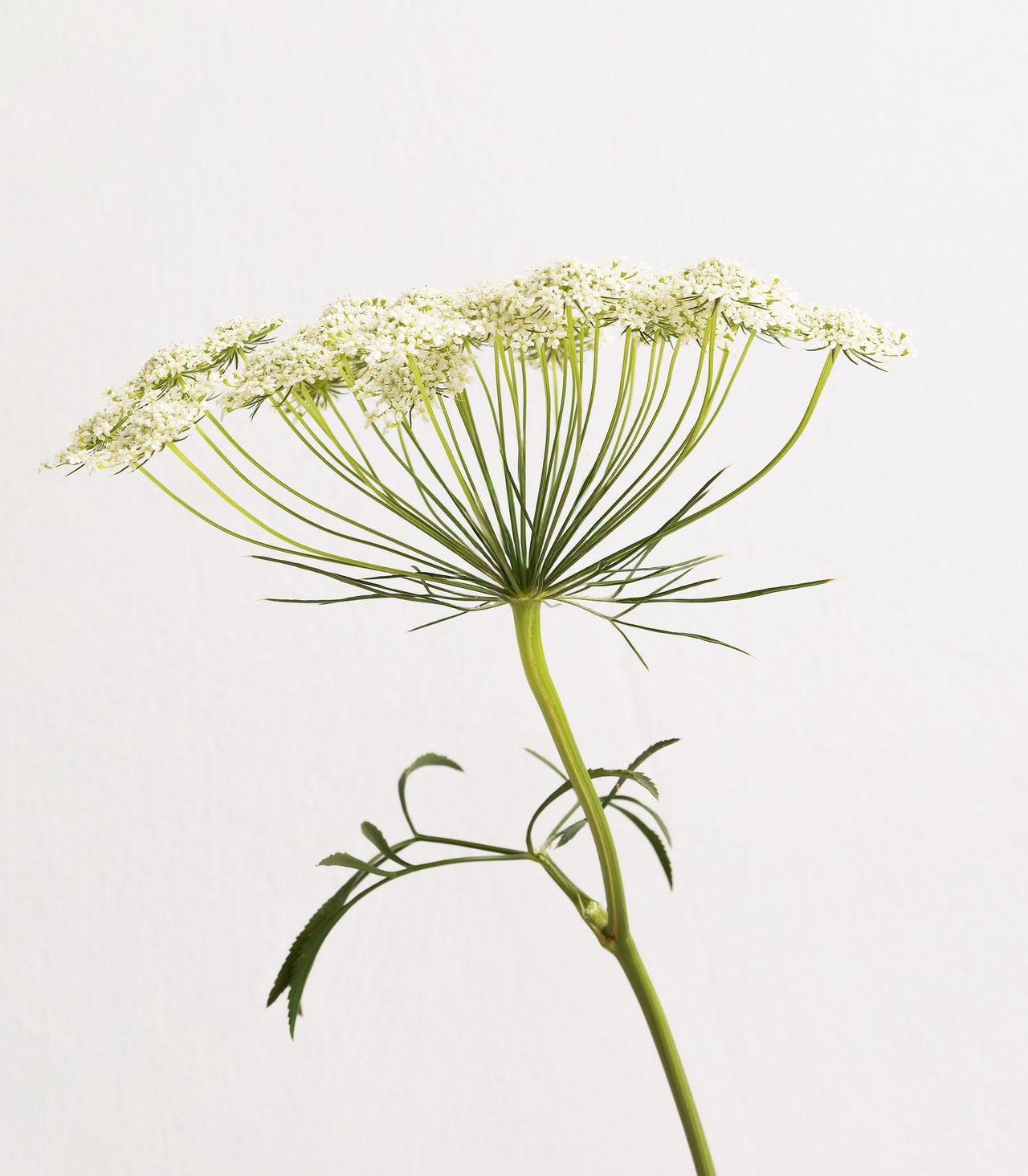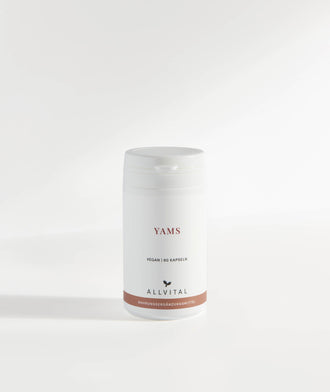
Naturally through the menopause with yams
The yam root is a natural remedy for menopausal symptoms. It has been used for centuries by indigenous peoples and in traditional medicine. We present the latest scientific findings on the subject.Yams as an alternative to hormone supplements?
The menopause is characterised by strong hormonal changes and can bring with it various physical and psychological symptoms, some of which have a considerable impact on quality of life.
In recent years, yams have received increased attention as a possible natural remedy for menopausal symptoms. Study results suggest that extracts from the plant could regulate the human hormone balance.
Many women seek a natural alternative to the use of hormone supplements, as synthetic hormones can have serious side effects, ranging from breast cancer to thrombosis and other cardiovascular problems. Yam root could be such an alternative. So far, however, there have only been a few studies investigating its use in humans.
What is yams?
Yams (Dioscorea) is a plant genus within the yam family, which comprises around 800 species. It is mainly cultivated in Africa and South America. By far the largest cultivation area is in Nigeria. However, some species are also found in Europe and Asia (1).
Yam plants often grow climb several meters high and form underground tubers, that act as storage organs rich in starch, fibre and protein. The tubers also contain various micronutrients (e.g. potassium, magnesium) and secondary plant substances. These storage organs are known as rhizomes or yam roots. The tubers are dug up and used as food or medicine (1).
Most species are poisonous when raw and can therefore only be eaten when cooked or otherwise heated. Yam roots have a floury consistency and taste similar to potatoes and sweet potatoes, but are not related to these plants (1).
Traditional use
Yams have been used for centuries in traditional medicine in South America and China. In particular, it is known to be used for various "women's complaints" such as menstrual cramps, pain during childbirth or to alleviate menopausal symptoms. The plant's ingredients are also said to have a rejuvenating effect, strengthen bones, inhibit inflammation, promote blood circulation and more. The traditional uses are therefore many and varied.
What is the effect of yams based on?
The different types of yam contain a variety of secondary plant substances. Secondary plant substances are, for example, important for the growth and development of plant itself, and act as signalling substances or serve as defence against predators and pathogens (1).
Substances from the following classes have been identified: flavonoids, phenols, saponins, tannins and alkaloids. All of these substance classes comprise a large number of individual substances. Additionally, different combinations of these secondary plant substances have been detected in different yam species (1).
Secondary plant substances have a variety of effects on human health. For example, some of these substances have an antioxidant, antimicrobial or anti-cancer effect. They can influence the immune system, the hormone system, digestion and many other processes in our body.
Diosgenin (Yams) to support the endocrine system
With regard to the hormonal household and a possible influence on menopausal symptoms, diosgenin, which belongs to the saponin class of substances, is of particular scientific interest. Diosgenin is found in high concentrations mainly in the Mexican and Chinese yam (1).
Diosgenin is similar in its chemical structure to the human steroid hormones. These include sex hormones such as progesterone, oestrogen and testosterone and hormones of the adrenal cortex such as cortisone.
How diosgenin is metabolised in the human body and whether hormonally active components can arise from it has not yet been clarified. It is also not clear whether other ingredients in the plant besides diosgenin are responsible for the possible effect on the hormone system.
Yams for menopausal symptoms
Menopause is characterised by decreasing oestrogen and progesterone levels and increased hormonal fluctuations. Yam root is said to have a balancing effect on the hormonal household, especially at the beginning of the menopause. Numerous patient testimonials can be found on the Internet, but the number of studies on humans is small.
Below we present some studies that pursued the effects of yams during menopause:
In a study from Taiwan, 50 women with menopausal symptoms were given either an extract of water yam (Dioscorea alata) or a placebo. The study lasted 12 months. After just 6 months, the women taking the extract showed an improvement in psychological symptoms, sleep quality and various pain symptoms. The hormone profile in the blood also improved. The women in the study took 24 mg of the extract per day (2).
Another Taiwanese study showed that the consumption of the entire yam root as a food item, can have a positive effect and, for example, favourably influence the hormone profile in the blood and the cholesterol levels in menopausal women. In this study, women ate 390 g of yam root daily, split across multiple meals (3).
In the above-mentioned studies, the drop in oestrogen levels in particular was re-balanced. Other human studies from Asia showed an oestrogenic effect of yam (1) (4).
In cell and animal studies, diosgenin has also been successfully used to protect against accelerated skin ageing during the menopause (5).
Other possible effects
In addition to its influence on the symptoms of menopause, studies also show that yams may be effective against osteoporosis (6), neuro-degenerative diseases such as Parkinson's and Alzheimer's (7), cancer (1), obesity and diabetes (1).
It is important to note that research into the use of yam extracts in humans is still in its infancy and there is not yet sufficient data available on the optimal effective dose and safety profile.
Intake and dosage of yams
Yam root is available in various forms. The most common are capsules, creams and tinctures. The preparations usually contain concentrated amounts of diosgenin and are mostly marketed for the treatment of menopausal symptoms.
The dosage and intake of yam should be in accordance with the recommendations of a knowledgeable therapist. This is particularly important if you are already taking synthetic hormone supplements. It should not be taken during pregnancy. Usual dosages for capsules vary between 300 and 600 mg of the extract per day.
Does yam root have side effects?
Side effects from the use of yam supplements are rare. Undesirable effects can be, for example, digestive problems when using capsules or skin reactions after applying localised creams.
Yams from Allvital
Our Yams supplement contains the extract and powder of the Mexican yam root, which has a very high diosgenin content of 20 %. It also contains Indian gooseberry, which is a natural source of vitamin C and contains other micronutrients and secondary plant substances that support the yam root in its effectiveness.
Sources
- Obidiegwu JE, Lyons JB, Chilaka CA. The Dioscorea Genus (Yam)-An Appraisal of Nutritional and Therapeutic Potentials. Foods. 2020;9(9):1304. Published 2020 Sep 16.
- Hsu CC, Kuo HC, Chang SY, Wu TC, Huang KE. The assessment of efficacy of Diascorea alata for menopausal symptom treatment in Taiwanese women. Climacteric. 2011;14(1):132-139.
- Wu WH, Liu LY, Chung CJ, Jou HJ, Wang TA. Estrogenic effect of yam ingestion in healthy postmenopausal women. J Am Coll Nutr. 2005;24(4):235-243.
- Lu J, Wong RN, Zhang L, et al. Comparative Analysis of Proteins with Stimulating Activity on Ovarian Estradiol Biosynthesis from Four Different Dioscorea Species in vitro Using Both Phenotypic and Target-based Approaches: Implication for Treating Menopause. Appl Biochem Biotechnol. 2016;180(1):79-93.
- Tada Y, Kanda N, Haratake A, Tobiishi M, Uchiwa H, Watanabe S. Novel effects of diosgenin on skin aging. Steroids. 2009;74(6):504-511.
- Alcantara EH, Shin MY, Sohn HY, et al. Diosgenin stimulates osteogenic activity by increasing bone matrix protein synthesis and bone-specific transcription factor Runx2 in osteoblastic MC3T3-E1 cells. J Nutr Biochem. 2011;22(11):1055-1063.
- Cai B, Zhang Y, Wang Z, et al. Therapeutic Potential of Diosgenin and Its Major Derivatives against Neurological Diseases: Recent Advances. Oxide Med Cell Longev. 2020;2020:3153082. Published 2020 Mar 6.


